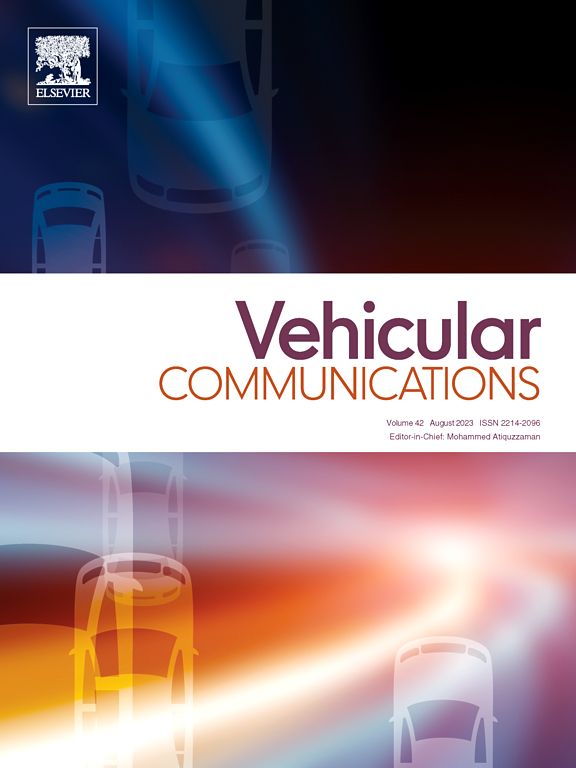RSU-assisted V2X message fusion via PC5 and Uu with actor–critic modeling for autonomous driving under intersection scenario
IF 6.5
2区 计算机科学
Q1 TELECOMMUNICATIONS
引用次数: 0
Abstract
Autonomous driving systems rely heavily on effective data fusion from Vehicle-to-Everything (V2X) networks, where accurate decisions depend on integrating diverse messages from multiple communication interfaces. However, current single-interface communication methods, either PC5 or Uu, limit the achievable autonomy level due to insufficient reliability and situational awareness. To address these limitations, this paper proposes an efficient RSU-centered Message-level fusion framework tailored for intersection-based autonomous driving. The proposed approach strategically assigns CAM, CPM, and SPATEM to the PC5 interface, while DENM and MAPEM are assigned to the Uu interface. A confidence-weighted fusion algorithm is implemented at the RSU aligns timestamps, filters inconsistent inputs, and resolves conflicts to generate unified situational awareness messages every 100 ms. The onboard decision-making model employs a CNN–GRU enhanced Actor–Critic network to optimize decisions for intelligent lane changing, collision avoidance, and traffic flow management. Simulation outcomes confirm that the proposed dual-interface fusion significantly enhances performance compared to single-interface systems, improving the packet delivery ratio to 0.75 at 300 m and achieving decision accuracy improvements of approximately 14–25% across key use cases. Consequently, our framework meets the criteria for autonomy sub-level L4-C, providing a robust foundation for advanced intersection-based autonomous driving systems.
rsu辅助下基于PC5和Uu的V2X信息融合及角色评价模型在十字路口场景下的自动驾驶
自动驾驶系统在很大程度上依赖于来自车联网(V2X)网络的有效数据融合,而在V2X网络中,准确的决策取决于整合来自多个通信接口的各种信息。然而,目前的单接口通信方法,无论是PC5还是Uu,由于可靠性和态势感知能力不足,限制了可实现的自主水平。为了解决这些限制,本文提出了一个高效的以rsu为中心的消息级融合框架,为基于交叉口的自动驾驶量身定制。该方法将CAM、CPM和SPATEM分配到PC5接口,而将DENM和MAPEM分配到Uu接口。在RSU上实现了一种置信度加权融合算法,该算法对时间戳进行对齐,过滤不一致的输入,并解决冲突,以每100毫秒生成统一的态势感知消息。车载决策模型采用CNN-GRU增强型Actor-Critic网络来优化智能变道、避碰和交通流量管理的决策。仿真结果证实,与单接口系统相比,所提出的双接口融合显着提高了性能,在300米处将数据包投递率提高到0.75,并在关键用例中实现了大约14-25%的决策精度提高。因此,我们的框架符合自主子级L4-C的标准,为先进的基于交叉口的自动驾驶系统提供了坚实的基础。
本文章由计算机程序翻译,如有差异,请以英文原文为准。
求助全文
约1分钟内获得全文
求助全文
来源期刊

Vehicular Communications
Engineering-Electrical and Electronic Engineering
CiteScore
12.70
自引率
10.40%
发文量
88
审稿时长
62 days
期刊介绍:
Vehicular communications is a growing area of communications between vehicles and including roadside communication infrastructure. Advances in wireless communications are making possible sharing of information through real time communications between vehicles and infrastructure. This has led to applications to increase safety of vehicles and communication between passengers and the Internet. Standardization efforts on vehicular communication are also underway to make vehicular transportation safer, greener and easier.
The aim of the journal is to publish high quality peer–reviewed papers in the area of vehicular communications. The scope encompasses all types of communications involving vehicles, including vehicle–to–vehicle and vehicle–to–infrastructure. The scope includes (but not limited to) the following topics related to vehicular communications:
Vehicle to vehicle and vehicle to infrastructure communications
Channel modelling, modulating and coding
Congestion Control and scalability issues
Protocol design, testing and verification
Routing in vehicular networks
Security issues and countermeasures
Deployment and field testing
Reducing energy consumption and enhancing safety of vehicles
Wireless in–car networks
Data collection and dissemination methods
Mobility and handover issues
Safety and driver assistance applications
UAV
Underwater communications
Autonomous cooperative driving
Social networks
Internet of vehicles
Standardization of protocols.
 求助内容:
求助内容: 应助结果提醒方式:
应助结果提醒方式:


